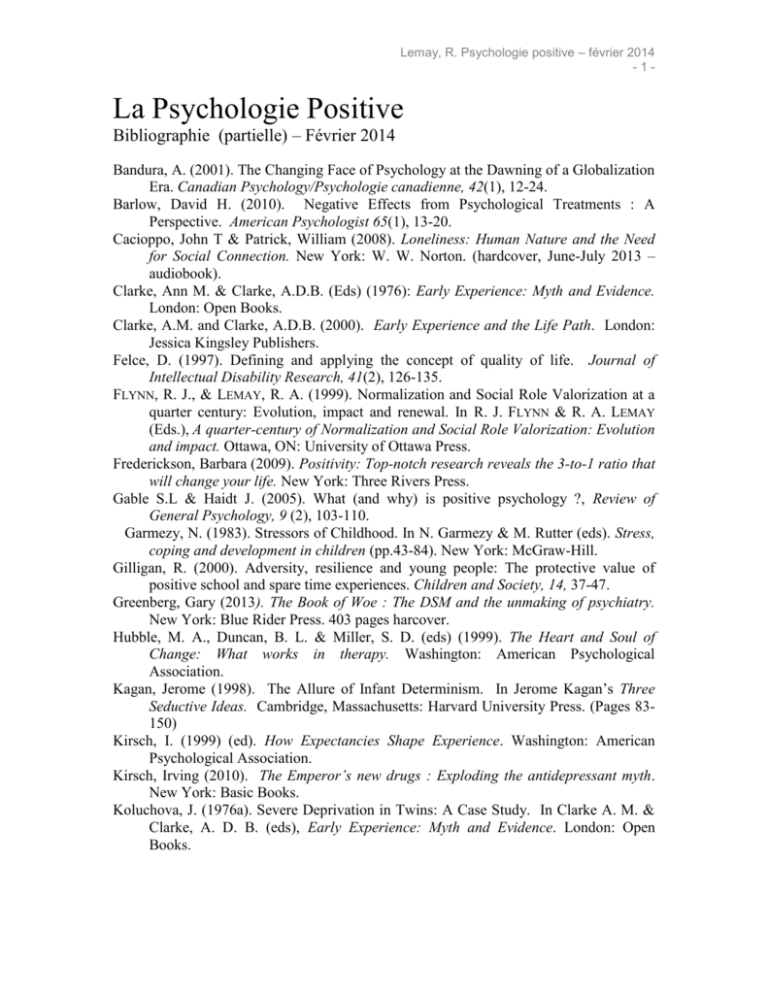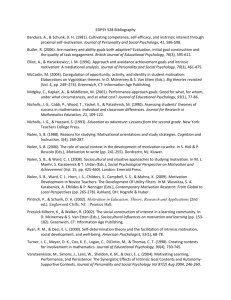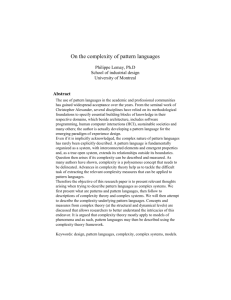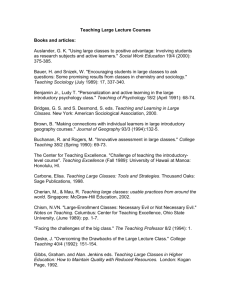Psychologie positive (Bibliographie)
advertisement

Lemay, R. Psychologie positive – février 2014 -1- La Psychologie Positive Bibliographie (partielle) – Février 2014 Bandura, A. (2001). The Changing Face of Psychology at the Dawning of a Globalization Era. Canadian Psychology/Psychologie canadienne, 42(1), 12-24. Barlow, David H. (2010). Negative Effects from Psychological Treatments : A Perspective. American Psychologist 65(1), 13-20. Cacioppo, John T & Patrick, William (2008). Loneliness: Human Nature and the Need for Social Connection. New York: W. W. Norton. (hardcover, June-July 2013 – audiobook). Clarke, Ann M. & Clarke, A.D.B. (Eds) (1976): Early Experience: Myth and Evidence. London: Open Books. Clarke, A.M. and Clarke, A.D.B. (2000). Early Experience and the Life Path. London: Jessica Kingsley Publishers. Felce, D. (1997). Defining and applying the concept of quality of life. Journal of Intellectual Disability Research, 41(2), 126-135. FLYNN, R. J., & LEMAY, R. A. (1999). Normalization and Social Role Valorization at a quarter century: Evolution, impact and renewal. In R. J. FLYNN & R. A. LEMAY (Eds.), A quarter-century of Normalization and Social Role Valorization: Evolution and impact. Ottawa, ON: University of Ottawa Press. Frederickson, Barbara (2009). Positivity: Top-notch research reveals the 3-to-1 ratio that will change your life. New York: Three Rivers Press. Gable S.L & Haidt J. (2005). What (and why) is positive psychology ?, Review of General Psychology, 9 (2), 103-110. Garmezy, N. (1983). Stressors of Childhood. In N. Garmezy & M. Rutter (eds). Stress, coping and development in children (pp.43-84). New York: McGraw-Hill. Gilligan, R. (2000). Adversity, resilience and young people: The protective value of positive school and spare time experiences. Children and Society, 14, 37-47. Greenberg, Gary (2013). The Book of Woe : The DSM and the unmaking of psychiatry. New York: Blue Rider Press. 403 pages harcover. Hubble, M. A., Duncan, B. L. & Miller, S. D. (eds) (1999). The Heart and Soul of Change: What works in therapy. Washington: American Psychological Association. Kagan, Jerome (1998). The Allure of Infant Determinism. In Jerome Kagan’s Three Seductive Ideas. Cambridge, Massachusetts: Harvard University Press. (Pages 83150) Kirsch, I. (1999) (ed). How Expectancies Shape Experience. Washington: American Psychological Association. Kirsch, Irving (2010). The Emperor’s new drugs : Exploding the antidepressant myth. New York: Basic Books. Koluchova, J. (1976a). Severe Deprivation in Twins: A Case Study. In Clarke A. M. & Clarke, A. D. B. (eds), Early Experience: Myth and Evidence. London: Open Books. Lemay, R. Psychologie positive – février 2014 -2- Koluchova, J. (1976b). A Report on the Further Development of Twins after Severe and Prolonged Deprivation. In Clarke A. M. & Clarke, A. D. B. (eds), Early Experience: Myth and Evidence. London: Open Books. LECOMTE (SD) QU’EST CE QUE LA PSYCHOLOGIE POSITIVE? HTTP://WWW.PSYCHOLOGIEPOSITIVE.NET/ (4 FÉVRIER 2014) LEMAY, R. (1996b). Normalization and Social Role Valorization. In A. DELL ORTO & P. MARINELLI (Eds.), The encyclopaedia of disability and rehabilitation. New York: MacMillan. LEMAY, R. (1996c). La Valorisation des Rôles Sociaux et le Principe de Normalisation: des lignes directrices pour la mise en oeuvre de contexts sociaux et de services humans pour les personnes à risque de dévalorisation sociale. The International Social Role Valorization Journal/La Revue Internationale de la Valorisation des Rôles Sociaux, 2(2), 15-21. LEMAY, R (1999). Roles, identities, and expectancies: Positive contributions of role theory to Normalization and Social Role Valorization. In R. J. Flynn & R. A. Lemay (Eds.), A quarter-century of Normalization and Social Role Valorization: Evolution and impact. Ottawa, ON: University of Ottawa Press. LEMAY, R (2001). Good Intentions and Hard Work Are Not Enough: Review of: Levy, P. F., (2001). The Nut Island Effect: When Good Teams Go Wrong. SRV-VRS: The International Social Role Valorization Journal, 4 (1&2), 94-97. LEMAY, R (2005). Resilience versus coping. Child & Family Journal, 8(2), 11-15. LEMAY, R (2005). Resilience, the developmental model and hope. Crucial Times, 34, 56. LEMAY, R (2004). Social Role Valorization versus drug therapies. SRV-VRS: The International Social Role Valorization Journal, 5(1&2), 3-17. LEMAY, R (2006). Social Role Valorization (S.R.V.) Insights Into the Social Integration Conundrum. Mental Retardation, 44(1), 1-12. LEMAY, R (2006). « J’entends des voix » : Le courant de la pensée, les hallucinations et l’intervention. Travail Social Canadien/ Canadian Social Work, 8(1), 98-112. LEMAY, R (2009). Life imitating art, and the six ages of a homeless musician: A review essay on The Soloist (Lopez, 2008), the story of Nathaniel Anthony Ayers Jr. The Social Role Valorization Journal. Lemay, R., & Ghazal, H. (2001). Resilience and positive psychology : Finding hope. Child & Family, 5(1), 10-21. Lemay, R & Ghazal, H. (2007). Looking After Children in Canada: A practitioner’s guide. Ottawa: University of Ottawa Press. Lemay, R. (2007). The unsolved mystery of Gordon Thomas Page Jr. In S. Pacey (Ed.) Acts of a Conference: Myth Busting and Momentum Building, a community conference about truths in the lives of people with disabilities (pp. 23-32). Brisbane (AU): Community Resources Unit (CRU). Lemay, R et H. Ghazal (2008). S’occuper des enfants: Guide de l’intervenant. Ottawa: Presses de l’Université d’Ottawa. Lemay, R., Lalonde, M., Robinson, S., et Fournier, H. (2009). L’évaluation de la qualité des expériences et conditions de vie (QCEV). Plantagenet (ON-Canada) : Presses VALOR. Lemay, R. Psychologie positive – février 2014 -3- Lilienfeld, S. O., Lynn, S. J., Lohr, J. M., (Eds.) (2004). Science and Pseudoscience in Clinical Psychology. New York: The Guilford Press. Maddux, J.E. (2002). Stopping the “Madness”: Positive Psychology and the Deconstruction of the Illness Ideology and the DSM. . In C. R. Snyder, & S. J. Lopez (Eds.). Handbook of Positive Psychology. New York: Oxford University Press, pp. 13-25. Mash, E.J. & Hunsley, J. (2005). Evidence-Based Assessment of Child and Adolescent Disorders: Issues and Challenges. Journal of Clinical Child & Adolescent Psychology, 34 (3). 362-379. Maslow, A H. (1943). A Theory of Human Motivation. Psychological Review. 50(4), 370-396. Miller, S. D., Duncan, B. L., and Hubble, M. A. (1997). Escape from Babel: Toward a Unifying Language for Psychotherapy Practice. New York: W.W. Norton & Company. Monmaney, T. (1988). Kids who bounce back: Why things go right. Newsweek, September 12, p. 67. Montcrieff, J. (2008). The Myth of the Chemical Cure: A Critique of Psychiatric Drug Treatment. London: Palgrave Macmillan. Moynihan, R. & Cassels, A. (2005). Selling Sickness : How the world’s biggest pharmaceutical companies are turning us all into patients. New York: Nation Books. Panter-Brick, Catherine (2000). Nobody’s children? A reconsideration of child abandonment. In C. Panter-Brick and M. T. Smith (eds) Abandoned Children. Cambridge: Cambridge University Press. Redl, F., & Wineman, D. (1957). Controls from Within: Techniques for the Treatment of the Aggressive Child. Glencoe: The Free Press. Rutter, M. (1976). Parent-child separation: psychological effects on the children. In Clarke A. M. & Clarke, A. D. B. (eds), Early Experience: Myth and Evidence. London: Open Books. Schwartz, Jeffrey & Begley, Sharon (2002). The Mind and the Brain: Neuroplasticity and the power of mental force. New York: HarperCollins Publishers. Seligman, Martin E.P. (1990). Learned Optimism: How to change your mind and your life. New York: Pocket Books (Second Edition) Seligman M. E. P. (1999). The president address, American psychologist, 54 (8), 559562. Seligman, Martin, E.P. (2002). Authentic Happiness: Using the New Positive Psychology to Realize Your Potential for Lasting Fulfillment. New York: The Free Press. Seligman (2011). Flourish. New York: Free Press. Snyder, C. R. & Lopez,S. J. (Eds.) (2002). Handbook of Positive Psychology. New York: Oxford University Press, pp. 13-25. Thoits, P. A. (1995) March. Identity relevant events and psychological symptoms: A cautionary tail. Journal of Health and Social Behavior, 36, 72-82. Uttal, W. R. (2001). The New Phrenology: The limits of Localizing Cognitive Processes in the Brain. Cambridge: Massachussetts Institute of Technology Press. Lemay, R. Psychologie positive – février 2014 -4- Vaillant, G.R. & Vaillant, C.O. (1981). Natural History of Male Psychological Health, X: Work as a Predictor of Positive Mental Health. The American Journal of Psychiatry, 138(11). 1433-1440. Wiersma, D. (1996). Measuring social disabilities in mental health. Social Psychiatry and Psychiatric-Epidemiology, 31, 101-108. Willms, J. D. (2002). Vulnerable Children: Findings from Canada’s National Longitudinal Survey of Children and Youth. Edmonton: University of Alberta Press. WOLFENSBERGER, W. (1972). The principle of Normalization in human services. Toronto, ON: National Institute on Mental Retardation. Wolfensberger, Wolf (1988). Common Assets of Mentally Retarded People That Are Commonly Not Acknowledged. Mental Retardation. Vol. 26, No. 2, 63-70. WOLFENSBERGER, W. (2013). A brief introduction to Social Role Valorization: A highorder concept for addressing the plight of societally devalued people, and for structuring human services. (4th expanded edition). Plantagenet (ON): Valor Press. WOLFENSBERGER, W., & THOMAS, S. (1994). An analysis of the client role from a Social Role Valorization perspective. The International Social Role Valorization Journal, 1(1), 3-8. Wolfensberger, W., & Thomas, S. (2007). PASSING : A tool for analysing service quality according to Social Role Valorization criteria. Ratings manual (3rd ed.). Syracuse NY: Training Institute for Human Service Planning, Leadership and Change Agentry (Syracuse University). WOLFENSBERGER, W., THOMAS, S., & CARUSO, G. (1996). Some of the universal “good things of life” which the implementation of Social Role Valorization can be expected to make more accessible to devalued people. The International Social Role Valorization Journal/La Revue Internationale de la Valorisation des Rôles Sociaux, 3(2), 12-14. WOLFENSBERGER, W., & TULLMAN, S. (1982). A brief overview of the principle of Normalization. Rehabilitatio Psychology, 27(3), 131-145.






